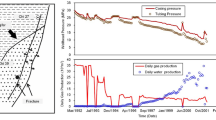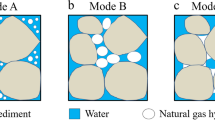During the gas production process, the permeability of a low-permeability volcanic gas reservoir increases with decreasing water saturation. Additionally, at constant water saturation, the permeability generally increases with decreasing pore pressure if the water saturation is lower than 40%, and the permeability increases slightly with increasing pore pressure if the water saturation is higher than 40%. We undertook this research work in the Kalamay volcanic gas reservoir in the Junggar Basin of China because this gas reservoir has typical seepage characteristics and there are unknown low-permeability volcanic gas reservoirs. Therefore, to study the seepage characteristics of gas in a low-permeability volcanic gas reservoir at different water saturations, we designed experimental methods of measuring the permeability, saturation, and flow rate in the course of core gas displacement to examine the effects of water saturation on gas seepage during the gas production process. In the study, we performed simulation experiments on eight volcanic cores sampled from three wells in the research area and analyzed their gas seepage characteristics at different levels of water saturation. The results reveal that the gas permeability of water-bearing volcanic reservoirs with low permeability values depends mainly on water saturation and pore pressure. Regardless of the slippage effect on the gas, the permeability of the reservoirs depends largely on the degree of original water saturation. In other words, the degree of water saturation directly determines the seepage capability of gas in reservoirs. The critical value of water saturation in the low-permeability volcanic gas reservoirs may be defined as 40%. When the water saturation is higher than 40%, the permeability increases with increasing pore pressure but does not increase substantially. Under these conditions, the gas seepage shows the characteristics of liquid-phase seepage, the gas-water seepage relation is complex, and the resistance to gas seepage is large. All of these make development very difficult and ineffective. When the water saturation is lower than 40%, the permeability increases with decreasing pore pressure, and the seepage characteristics of the gas follow those of a single-phase gas. Under these conditions, the degree of water saturation only influences the permeability of the reservoir and has little impact on the seepage characteristics of the gas.

Similar content being viewed by others
References
B. B. Bernard, J. M. Brooks, and W. M. Sackett. “Natural gas seepage in the Gulf of Mexico.” Earth Planetary Science Letters, 31, No. 1, 48-54 (1976).
M. Hovland and J. H. Sommerville. “Characteristics of two natural gas seepages in the North Sea.” Marine and Petroleum Geology, 2, No. 4, 319-326, (1985).
Author information
Authors and Affiliations
Additional information
Translated from Khimiya i Tekhnologiya Topliv i Masel, No. 2, pp. 40 – 43, March– April, 2015.
Rights and permissions
About this article
Cite this article
Liu, Z., Zhao, J., Liu, H. et al. Experimental Simulation of Gas Seepage Characteristics of a Low-Permeability Volcanic Rock Gas Reservoir Under Different Water Saturations. Chem Technol Fuels Oils 51, 199–206 (2015). https://doi.org/10.1007/s10553-015-0593-x
Published:
Issue Date:
DOI: https://doi.org/10.1007/s10553-015-0593-x




